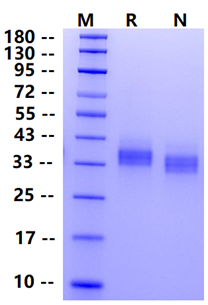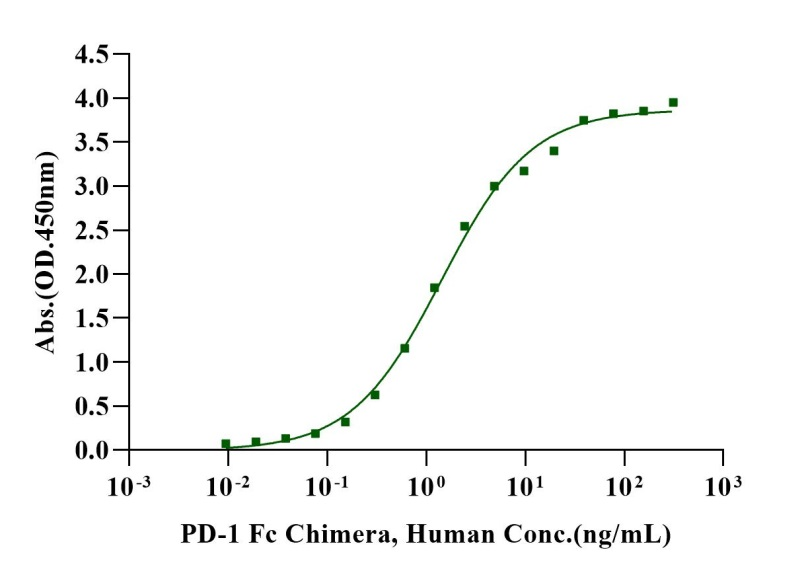1μg (R: reducing conditions, N: non-reducing conditions).
Product Details
Product Details
Product Specification
| Species | Human |
| Antigen | PD-L1 |
| Synonyms | PD-L1, CD274, B7-H1, PDCD1L1, PDCD1LG1 |
| Accession | Q9NZQ7 |
| Amino Acid Sequence | Phe19-Arg238, with C-terminal Avi&His Tag FTVTVPKDLYVVEYGSNMTIECKFPVEKQLDLAALIVYWEMEDKNIIQFVHGEEDLKVQHSSYRQRARLLKDQLSLGNAALQITDVKLQDAGVYRCMISYGGADYKRITVKVNAPYNKINQRILVVDPVTSEHELTCQAEGYPKAEVIWTSSDHQVLSGKTTTTNSKREEKLFNVTSTLRINTTTNEIFYCTFRRLDPEENHTAELVIPELPLAHPPNERGGGSGLNDIFEAQKIEWHEHHHHHHHH |
| Expression System | HEK293 |
| Molecular Weight | 33-40kDa |
| Purity | >95% by SDS-PAGE |
| Endotoxin | <0.1EU/μg |
| Conjugation | Biotin |
| Tag | Avi Tag, His Tag |
| Physical Appearance | Lyophilized Powder |
| Storage Buffer | PBS, pH7.4 |
| Reconstitution | Reconstitute at 0.1-1 mg/ml according to the size in ultrapure water after rapid centrifugation. |
| Stability & Storage | · 12 months from date of receipt, lyophilized powder stored at -20 to -80℃. · 3 months, -20 to -80℃ under sterile conditions after reconstitution. · 1 week, 2 to 8℃ under sterile conditions after reconstitution. · Please avoid repeated freeze-thaw cycles. |
| Reference | 1. Joel Sunshine, Janis M Taube: PD-1/PD-L1 inhibitors, Current Opinion in Pharmacology, Volume 23, August 2015, Pages 32-38. |
Background
PDL1 is a cell surface immunoglobulin superfamily with two Ig-like domains within the extracellular region and a short cytoplasmic domain. PDL1 is also known as B7-H, B7H1, MGC142294, MGC142296, PD-L1, PDCD1L1 and PDCD1LG1,which is a member of the growing B7 family of immune molecules and is involved in the regulation of cellular and humoral immune responses. PD-L1 provides a molecular stop signal to the adaptive immune system helping to distinguish between self and foreign antigens. PDL1 may inhibit ongoing T-cell responses by inducing apoptosis and arresting cell-cycle progression. Many cancers exhibit upregulated PD-L1 protein expression, and several cancers with high levels of PD-L1 have been associated with increased tumor aggressiveness and poor prognosis. Using new therapeutics that block the PD-L1:PD-1 interaction has proven successful in the clinic for many cancer types and has sparked great interest in the field of cancer immunotherapy.
Picture
Picture
SDS-PAGE

ELISA

Immobilized Biotinylated PD-L1 Avi&His Tag, Human (Cat. No. UA010541) at 2 μg/mL on Streptavidin precoated (0.5μg/well) plate, can bind PD-1 Fc Chimera, Human (Cat. No. UA010002) with EC50 of 1.21-1.70 ng/ml.




